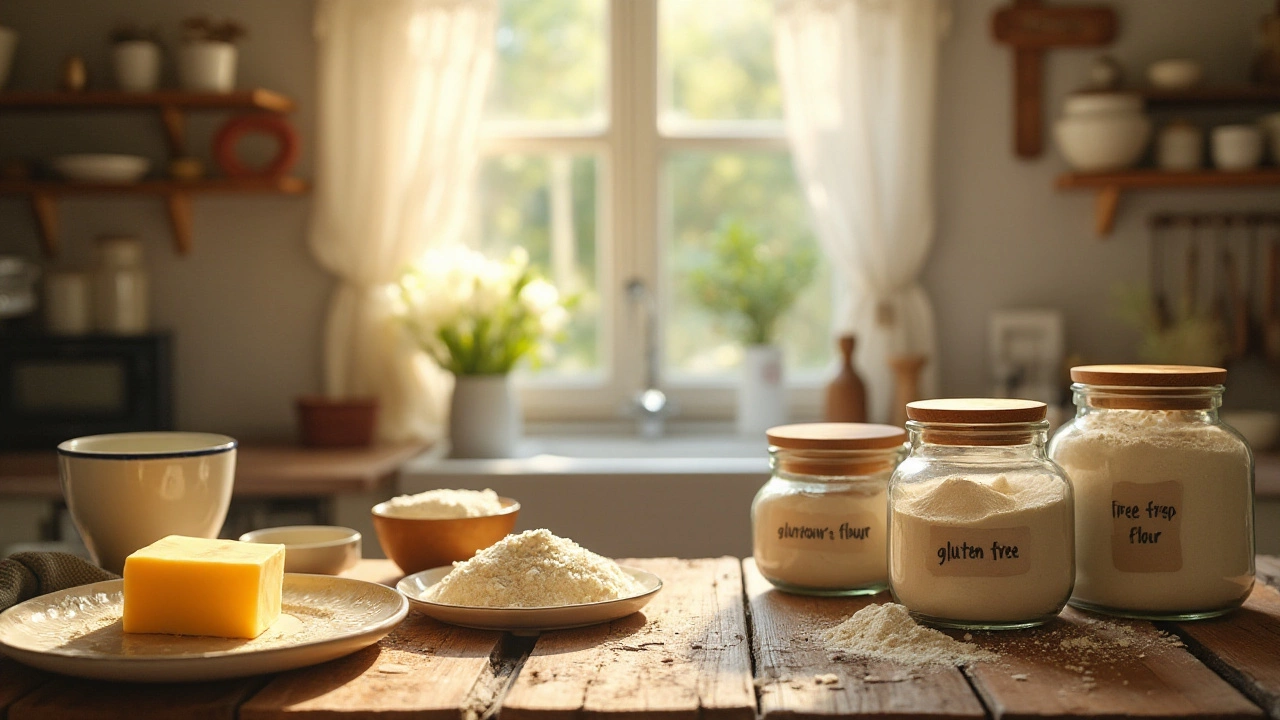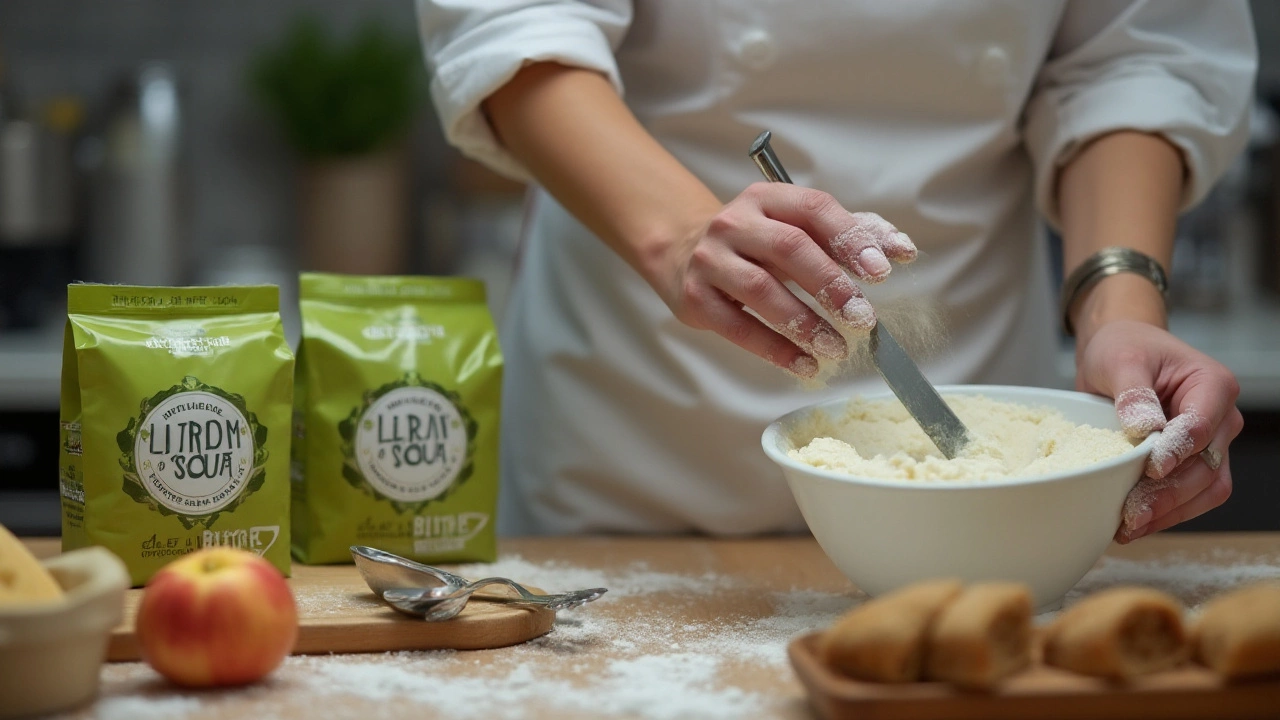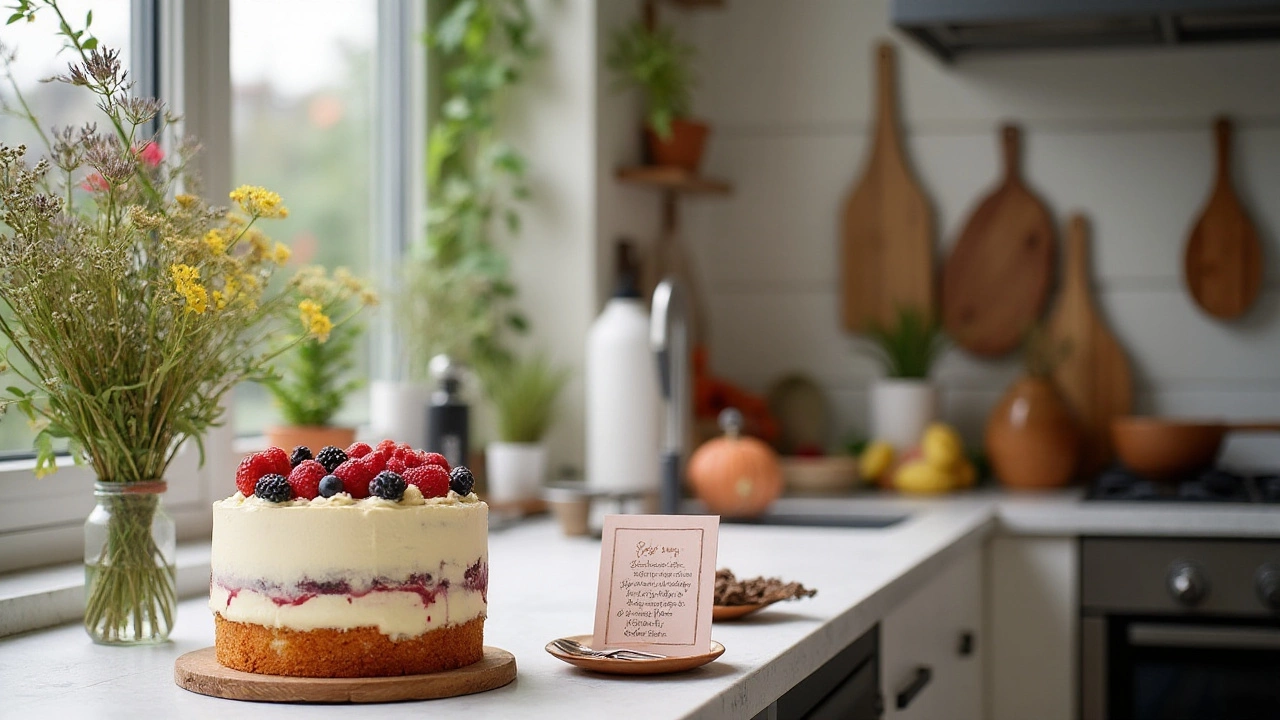
Welcome to the world of gluten-free baking where culinary creativity meets dietary needs. One question that often pops up is: does butter have gluten? For those who meticulously scan ingredient lists and fret over cross-contamination, this is not just a trivial curiosity—it’s essential culinary knowledge.
In this exploration, we'll dissect butter's role in your recipes, and unravel its gluten status so you can bake with confidence. With precision and practicality, we’ll tackle the vital aspects of gluten-free baking where butter stands as a star player or, in some cases, a sideline companion.
- Understanding Gluten
- The Role of Butter in Baking
- Is Butter Gluten-Free?
- Contamination Concerns
- Butter Substitutes for Gluten-Free Cakes
- Tips for Baking with Butter
Understanding Gluten
Let's dive into the fascinating and often misunderstood world of gluten. At its core, gluten is a family of proteins found in grains like wheat, rye, and barley. These proteins, primarily glutenin and gliadin, give dough its elasticity and help baked goods maintain their delightful chewiness. Whether you enjoy a fluffy loaf of bread or a tender cookie, gluten is usually the backbone of these textures. However, for those with celiac disease or a gluten sensitivity, this very element that makes our baked goods so pleasant can cause significant health problems.
Think of gluten as the binding glue that holds certain foods together, allowing them to rise and maintain their shape. When mixed with water, gluten forms a network of proteins that create the elastic texture necessary for shaping dough into various forms. The stronger the gluten network, the higher the rise and the chewier the baked product. Yet, as enthralling as this process might be to bakers and food enthusiasts alike, it's also the main antagonist in gluten-free baking. Those avoiding gluten must rely on alternative ingredients such as rice flour, almond flour, and xanthan gum to mimic gluten’s properties.
The rise in gluten-free diets over the past decade isn't solely due to celiac disease, an autoimmune disorder where ingestion of gluten leads to damage in the small intestine. Many have chosen this diet due to a perceived health boost, reducing symptoms that range from bloating and gas to headaches and fatigue. There's an increased awareness, backed by significant studies, which highlight how prevalent gluten sensitivity might be. According to a study conducted by The Celiac Disease Foundation, it is estimated that about 1% of the world's population is affected by celiac disease, yet a substantial number more might suffer from non-celiac gluten sensitivity, making the need for gluten-free options increasingly vital.
Mark Twain once said, "Training is everything. The peach was once a bitter almond; cauliflower is nothing but cabbage with a college education." Delve into your gluten-free journey with the same experimental spirit, transforming basic ingredients into delightful creations.Although gluten itself is not harmful to most people, understanding its role in both baking and health is critical to making informed dietary choices, especially if you are venturing into the realm of gluten-free baking. Many households blend multiple flours to strike the perfect balance of taste and texture, ensuring that desserts remain exquisite while accommodating lifestyle needs. Whether you opt for pre-mixed gluten-free flour or create your mix, knowing the basics of gluten makes the baking journey a bit clearer and more rewarding.
The Role of Butter in Baking
Baking is both an art and science, a wonderful intersection where precision and creativity collide. Among the many ingredients that bakers juggle, butter holds a special place, not just for taste but for its structural contributions. Start to break down the role of butter in baked goods, and you will uncover its profound impact on texture, moisture, and flavor. Butter, a delightful combination of water and fats, plays a key role in creating the moist and tender crumb that is prized in cakes. Its fats coat the flour's protein molecules, minimizing their interaction with water, and thus, gluten formation is reduced. This results in a softer crumb, making butter indispensable in achieving the desired consistency in many baked goods.
The magic of butter doesn't end with texture. Its flavors are rich and deep, enhancing the taste of even the simplest cake. When butter melts, it releases flavors that are hard to replicate with other fats. As butter heats, it imparts a golden brown hue through the Maillard reaction—an essential process that creates the toasty, caramel-like notes in baked delights. Many chefs and bakers argue that butter is not just an ingredient; it's the backbone of flavor. As chef Thomas Keller notes, "Butter is quintessentially French yet universally beloved, giving a luxurious mouthfeel to dishes across cuisines." The creamy nuances of butter make your cakes more memorable and delightful.
Additionally, butter contributes to leavening and rising. When beaten with sugar, its ability to trap air is critical. This trapped air expands during baking, which helps cakes to rise and become fluffy. This specific property is why many cake recipes start with creaming butter and sugar together. The air pockets formed become crucial in creating that light, airy structure you crave in cakes. Butter carries aromas exceptionally well, pairing beautifully with vanilla, chocolate, and fruits, further elevating the cake's sensory appeal.
It’s not always just about what butter does but also how it empowers bakers to achieve control. The temperature sensitivity of butter is another aspect of baking where precision takes center stage. Whether you are aiming for a flaky pastry, a rich cake, or a chewy cookie, mastering butter's temperature is critical. Cold butter is perfect for crusts, creating layers, while room temperature butter blends smoothly into batters. Each form of butter lends itself to specific textures, allowing for experimentation in the kitchen.
Not surprisingly, the role of butter in baking surpasses any mere ingredient status. It is a primary player in altering, enhancing, and controlling the baking process. As bakers explore gluten-free alternatives, understanding butter's multi-faceted contributions becomes vital in crafting gluten-free cakes that do not compromise on quality. In gluten-free baking, where texture and moisture can sometimes stray, butter’s role becomes even more critical in helping bakers steer their creations toward success.

Is Butter Gluten-Free?
When it comes to baking gluten-free cakes, understanding every ingredient's role and composition is vital, particularly the use of butter. Fortunately, butter in its pure form is naturally gluten-free. Made from the fatty portion of milk, butter is simply churned cream that embodies richness and flavor without introducing gluten into the mix. Gluten is a protein found in wheat, barley, and rye, and since dairy cows certainly don't graze in wheat fields, we can rest assured that butter from pure sources does not contain gluten.
Of course, while pure butter is inherently gluten-free, the devil is in the details. Where caution comes into play is with flavored or reduced-fat butters. These often include additives or flavorings that may contain gluten or have been processed in facilities that handle gluten-containing products. For this reason, always checking labels for any mysterious hidden ingredients is necessary, especially if you're specifically avoiding gluten due to celiac disease or gluten sensitivity.
Cynthia Kupper, the executive director of the Gluten Intolerance Group, advises, "Reading labels isn't about memorizing which foods are safe but learning how to identify potential sources of gluten. It's essential for anyone on a gluten-free diet."
Another important consideration in keeping butter free from gluten contamination lies in how we handle it at home. Shared cutting boards, knives, and even butter dishes pose a risk if they come into contact with bread or other gluten-laden foods. Adopting good kitchen practices by having dedicated tools and dishes for gluten-free cooking can help mitigate these risks, ensuring butter remains a safe ingredient in your gluten-free culinary creations.
As you delve into the world of gluten-free baking, knowing that your staple of butter is safe can open a treasure trove of cake recipes without the worry of gluten. From fluffy sponge cakes to decadent chocolate layers, butter not only adds flavor but enhances texture and moisture, all while adhering to your dietary requirements. So, indulge in the creamy delight butter brings to your kitchen, while keeping a mindful eye on conditions that could introduce gluten into the mix.
Contamination Concerns
When diving into gluten-free baking, contamination concerns cannot be overlooked, especially for those with Celiac disease or a severe sensitivity. Though butter in its pure form doesn’t contain gluten, the risk lies in how it might be handled or processed. For instance, if you store your butter alongside products containing gluten, or if you use the same utensils for butter and gluten-containing foods, you inadvertently expose yourself to contamination risks. Cross-contamination becomes a concern even in seemingly innocuous settings such as your own kitchen, where crumbs from bread or baked goods might quietly compromise your buttery baking adventures.
In commercial settings, the situation can be even more complex, though many producers are aware of cross-contamination risks and take precautions. It is crucial to check labels and choose brands that process their butter in a gluten-free environment. Some producers proudly indicate this on their packaging, but it’s wise to delve into the details, even contact customer service if unsure. It’s a good practice for peace of mind—and safety.
Reading Labels and Choosing Safe Products
Reading labels diligently is more than a practice; it’s a skill when ensuring a gluten-free diet. Labels might not directly show gluten content, but understanding terms and seeking certifications like ‘Certified Gluten-Free’ can be peace of reassurance. Butter itself is generally gluten-free, yet vigilance is necessary with flavored or compounded variants that might contain gluten as a hidden ingredient. Some might include additives or flavorings derived from gluten, which could slip under radar if only viewed superficially. Scan for safe alternatives, as they’re out there but demand patience and scrutiny.
Then, let’s talk about maintaining the integrity of your gluten-free kitchen. Implement thoughtful routines such as dedicating utensils, boards, and toasters strictly for gluten-free baking. In buzzing households with mixed dietary needs, something as small as color-coded tools might save you from potential exposure. This avoids confusion and mishaps easily avoidable with organizational changes tailoring to gluten-free needs.
“Creativity is the key to ingredients in the gluten-free kitchen. Use dedicated tools to maintain your recipe's purity, and read labels like you read words from a great novel.” — Martha Hart, Food Safety Advocate
Understanding these facets can greatly enhance your confidence and precision when baking gluten-free. By safeguarding your gluten-free baking practices, you ensure peace of mind and ultimately, safety for those you’re baking for. It’s not merely about substitutions; it’s a holistic approach involving knowledge, vigilance, and earnest effort to keep contamination at bay. The small details matter, transforming what is often seen as compromise into a tapestry of creativity and care in your culinary journey.

Butter Substitutes for Gluten-Free Cakes
Many adventurous bakers are constantly on the hunt for alternatives to traditional ingredients, not just out of necessity but as a thrilling exercise in culinary innovation. If you're aiming to make a delectable gluten-free cake while avoiding butter, you're in for a treat. Embracing substitutes not only riffs on flavors but can also cater to different dietary preferences, whether due to lactose intolerance or vegan choices. One noted substitute is coconut oil. It's a versatile fat, with both solid and melted applications, that lends a subtle coconut aroma which can complement cakes wonderfully. Its composition allows for a near-direct substitution for butter in gluten-free recipes — usually in a 1:1 ratio, though a tad extra might be needed in some instances to reach the desired texture.
Another delightful pastry partner is applesauce, which not only lightens the calorie load but also infuses a gentle sweetness into your cake. Replacing butter with applesauce tends to work best in recipes requiring moisture — think rich chocolate gluten-free cakes. It’s this extra moisture that creates a spongy texture, sometimes needing additional adjustments like slightly reducing other liquid elements in your recipe. Consider using half the amount of applesauce for butter, keeping an eye on the batter consistency.
For those craving a creamy texture akin to butter, avocado is a stellar choice. When mashed, this fruit's buttery texture blends seamlessly into cake batters. Besides being heart-healthy with its monounsaturated fats, avocado offers a unique opportunity to add a slight green tint and earthy undertone to your cakes. Use it as a one-to-one replacement; however, it's best suited for recipes where its flavor can blend in, like gluten-free chocolate or spice cakes.a sweet, subtle hint to various bakes.
According to the well-regarded culinary expert, Alice Waters, "Fresh, local ingredients are key to incredible flavors." Embracing ingredient diversity like fresh avocado or apples can redefine dessert experiences.
Of course, don't overlook the humble olive oil, often touted as a savory ally. In the realm of baking, it provides unmatched moisture and crumb, with a touch of sophistication. Opt for mild varieties to ensure the olive flavor isn't overpowering, and replace butter with about 25% less oil by weight to maintain balance. Olive oil pairs well in citrus-flavored cakes and adds depth when drizzled generously.
Naturally-derived nut butters like almond or cashew butter can offer an intriguing, nutty alternative in gluten-free baking. Packed with protein, they enrich cakes with both texture and flavor. Be mindful, as using these might slightly alter baking time due to their density, so keeping watchful eyes during baking is crucial. Remember, experimenting with a diverse range of ingredients can yield surprising and delicious results, ensuring your gluten-free cake journey is as satisfying as those made with traditional butter.
Below is a quick rundown of some popular butter substitutes in gluten-free cakes:
- Coconut Oil: Use in a 1:1 ratio; adds light coconut flavor.
- Olive Oil: Use 25% less; opt for milder varieties.
- Applesauce: Best for moist cakes; use ½ amount.
- Mashed Avocado: Ideal for chocolate/spice cakes; use 1:1 for butter.
- Nut Butters: Adds density and flavor; adjust baking time accordingly.
Tips for Baking with Butter
Baking with butter can truly elevate your gluten-free cakes, lending richness and a golden hue that margarine or oil just can't compete with. However, to make sure your delicious confections reach their full potential, there are several things to keep in mind. First, the quality of butter you choose can significantly impact the taste and texture of your cake. It’s advisable to opt for unsalted butter so you can control the salt levels in your recipe. Freshness matters too, as butter absorbs odors easily in the fridge, which can affect flavor. A simple trick is to always make sure it is stored in its original packaging inside an airtight container.
Temperature is another key factor. Bringing butter to room temperature before you start makes it easier to cream with sugar, resulting in a light, fluffy texture in your cakes. This creaming process creates tiny air pockets that help with leavening, giving cakes that perfect rise. However, avoid melting the butter unless the recipe specifically requires it, as this changes the cake's texture, making it denser. Consistency in measurements is crucial too. For those without a kitchen scale, using the water displacement method can ensure accuracy. This ensures that the amount used aligns with what your recipe demands.
Butter in baking is not just about flavor; it also contributes to the structure. The fats in butter create tender layers in doughs, which is especially desirable for layered cakes. But too much can lead to greasy cakes, so precision in measurements matters. If you’re experimenting with less traditional flours like almond or coconut flour, butter’s richness can balance their nutty profiles, yet adjustments in the amount you’re using might be necessary. Edith Parker, a well-regarded pastry chef, once mentioned, "Butter's versatility can make or break your gluten-free dessert; understanding its properties is your first step towards baking mastery."
When mixing, use the spatula folding method to gently incorporate all ingredients, allowing the butter to stay aerated and the cake to remain fluffy. Over-mixing can create a tough cake texture due to excess gluten development, even with gluten-free flour mixes, because of their binding agents. If possible, invest in a stand mixer as it provides consistent results, but mixing by hand in gentle strokes also works well. Lastly, the baking process itself benefits from a focus on details: preheating is essential, as baking your cake in an evenly heated oven ensures that the butter in your batter reacts correctly for optimal texture and flavor.
For those interested in experimenting further, consider adjusting baking temperatures by just a few degrees to find the sweet spot where your specific oven does its best work with your butter-rich batter. Watching your cake like a hawk in those final minutes ensures it doesn’t overbake or underbake, preserving that light and tender crumb. As you venture into the exciting world of gluten-free baking, having these tips as your guide will help you wield butter's magic to your advantage, resulting in consistently delicious and visually enticing gluten-free cakes.